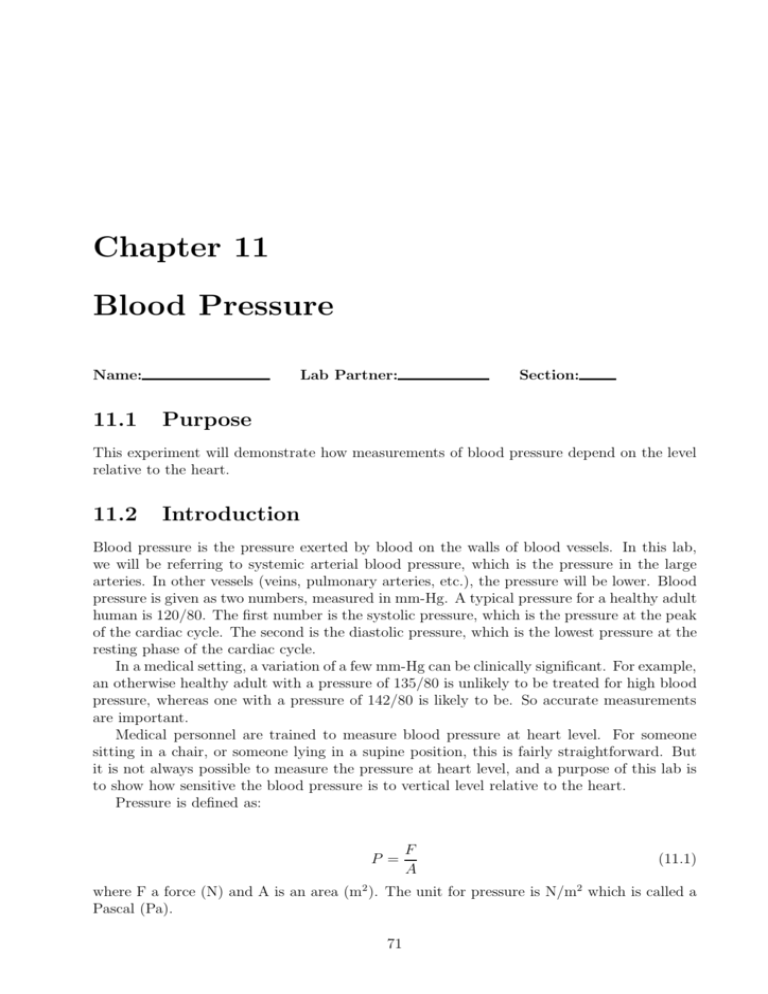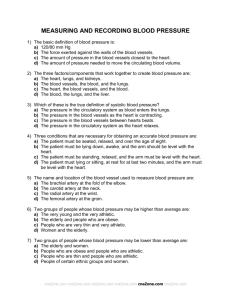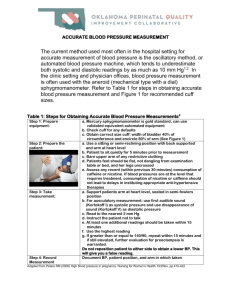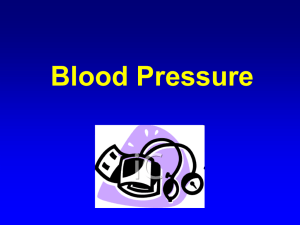Chapter 11 Blood Pressure
advertisement

Chapter 11 Blood Pressure Lab Partner: Name: 11.1 Section: Purpose This experiment will demonstrate how measurements of blood pressure depend on the level relative to the heart. 11.2 Introduction Blood pressure is the pressure exerted by blood on the walls of blood vessels. In this lab, we will be referring to systemic arterial blood pressure, which is the pressure in the large arteries. In other vessels (veins, pulmonary arteries, etc.), the pressure will be lower. Blood pressure is given as two numbers, measured in mm-Hg. A typical pressure for a healthy adult human is 120/80. The first number is the systolic pressure, which is the pressure at the peak of the cardiac cycle. The second is the diastolic pressure, which is the lowest pressure at the resting phase of the cardiac cycle. In a medical setting, a variation of a few mm-Hg can be clinically significant. For example, an otherwise healthy adult with a pressure of 135/80 is unlikely to be treated for high blood pressure, whereas one with a pressure of 142/80 is likely to be. So accurate measurements are important. Medical personnel are trained to measure blood pressure at heart level. For someone sitting in a chair, or someone lying in a supine position, this is fairly straightforward. But it is not always possible to measure the pressure at heart level, and a purpose of this lab is to show how sensitive the blood pressure is to vertical level relative to the heart. Pressure is defined as: P = F A (11.1) where F a force (N) and A is an area (m2 ). The unit for pressure is N/m2 which is called a Pascal (Pa). 71 The variation of pressure with height is given by: P = P0 + ρgh (11.2) where P is the pressure in Pascal (N/m2 ), P0 is the pressure at the reference point, ρ is the fluid density in units of kg/m3 , g is the acceleration of gravity, and h is the height relative to the reference point in meters. When using equation 11.2 the units for the pressure must be in Pascal. The density of blood is approximately 1060 kg/m3 . For conversion of pressure units use: 133.3 Pa = 1 mm-Hg. It should also be noted that the unit mm-Hg is called a torr in scientific literature. Since the human circulatory system is a closed ’piping’ system, the blood pressure should also obey this formula. By plotting the blood pressure as a function of height, one should get a straight line with a slope of ρg when using equation 11.2 11.3 Procedure Special Cautions: Measurement of blood pressure is a medical procedure. No student is required to participate in having their blood pressure measured, and no student who declines to have their pressure measured is to be ask for the reason. Students who do not have their blood pressure measured may use another student’s data. Blood pressure measurements can vary by up to 10-20 points during the day (especially the systolic pressure). Also, some medications can cause a temporary increase of 20 points or more (Sudafed is notorious for raising blood pressure). If your reading is above normal by 10-20 points, you should not be overly concerned about it. Everyone should measure their blood pressure every so often, and mention it to your physician if it is usually high. • Place the cuff on your arm, with the arrow facing up. The arrow should pointing down towards your hand and be about 1 cm from the crease in your arm. Adjust the cuff so that it is snug but not too tight. • For the first measurement, while you are seated, hang your arm loose at your side. Measure and record the vertical distance from the level of your heart to the tip of the arrow on the cuff. The level of your heart is approximately 2 centimeters above the tip of your sternum (breastbone). The precise location does not matter much, as long as you use the same level (reference point) throughout the lab. • Press the Start/Stop button on the machine and be still as the machine measures your blood pressure. Note: The cuff will become tight as it inflates with air. If, at any time, you feel uncomfortable, press the Start/Stop button and the cuff should deflate. • Record the systolic and diastolic blood pressures in the data table as given on the display (in mm-Hg). Record the height in the table. 72 Height (m) Systolic Pressure(mm-Hg) Systolic Pressure (Pa) Diastolic Pressure (mm-Hg) Diastolic Pressure (Pa) 1 2 3 4 5 • Wait approximately 5 minutes between consecutive blood pressure measurements. During that time, your lab partner can make their measurement. • For the second measurement, raise your arm a bit, higher than the first measurement but not yet at heart level and hold it there. Repeat the steps above for measuring your blood pressure and the height. • For the third measurement, measure your blood pressure at the level of your heart. • For the fourth measurement, raise your arm so the tip of the arrow is above heart level and hold it there. • For the fifth, and final, measurement, extend and hold your arm so that the tip of the arrow is as much above your heart as it can be. • Convert the pressure measurements from mm-Hg to Pascal. Convert the height measurements to meters. • Using the graph paper provided at the end of the chapter, plot the height in meters on the x-axis and the systolic pressure in mm-Hg on the y-axis. Draw a ’best fit’ line to the data points. Take the slope of the ’best fit’ line. Using the slope, calculate the density (ρ) using equation 11.2. Calculate the percentage error of the density with the standard value of 1060 kg/m3 . Slope of line from systolic pressure plot density (ρ) from systolic pressure plot Percent error of ρ • Repeat the last step using diastolic pressure. Slope of line from diastolic pressure plot density (ρ) from diastolic pressure plot Percent error of ρ 11.3.1 Questions 1. If a person were horizontal on a bed, would it matter if you measured the person’s blood pressure on their arm or their leg? 73 2. The density of mercury is 13,590 kg/m3 . Show that one mm-Hg (or 1 torr) is equal to 133.3 Pa. 11.4 Conclusion Write a detailed conclusion about what you have learned. Include all relevant numbers you have measured with errors. Sources of error should also be included. 74 75 76





